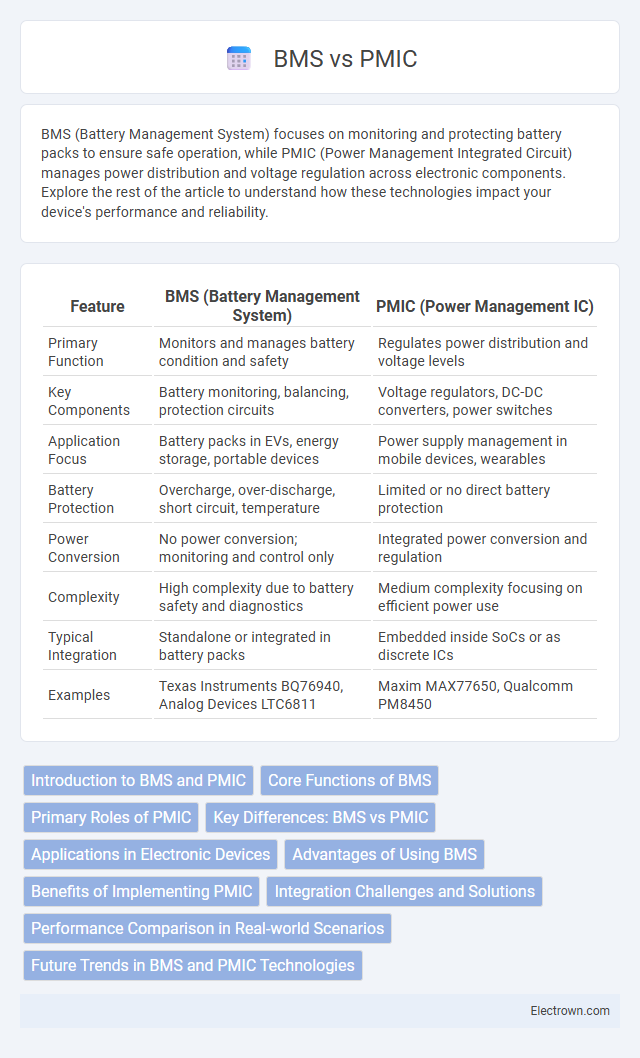BMS (Battery Management System) focuses on monitoring and protecting battery packs to ensure safe operation, while PMIC (Power Management Integrated Circuit) manages power distribution and voltage regulation across electronic components. Explore the rest of the article to understand how these technologies impact your device's performance and reliability.
Table of Comparison
| Feature | BMS (Battery Management System) | PMIC (Power Management IC) |
|---|---|---|
| Primary Function | Monitors and manages battery condition and safety | Regulates power distribution and voltage levels |
| Key Components | Battery monitoring, balancing, protection circuits | Voltage regulators, DC-DC converters, power switches |
| Application Focus | Battery packs in EVs, energy storage, portable devices | Power supply management in mobile devices, wearables |
| Battery Protection | Overcharge, over-discharge, short circuit, temperature | Limited or no direct battery protection |
| Power Conversion | No power conversion; monitoring and control only | Integrated power conversion and regulation |
| Complexity | High complexity due to battery safety and diagnostics | Medium complexity focusing on efficient power use |
| Typical Integration | Standalone or integrated in battery packs | Embedded inside SoCs or as discrete ICs |
| Examples | Texas Instruments BQ76940, Analog Devices LTC6811 | Maxim MAX77650, Qualcomm PM8450 |
Introduction to BMS and PMIC
Battery Management Systems (BMS) monitor and protect lithium-ion batteries by managing charge, discharge, temperature, and cell balancing to ensure safety and longevity. Power Management Integrated Circuits (PMIC) regulate voltage, distribute power efficiently, and support various power modes within electronic devices, optimizing overall energy use. Your choice between BMS and PMIC depends on whether you need comprehensive battery oversight or efficient power control for your application.
Core Functions of BMS
The core functions of a Battery Management System (BMS) include monitoring battery voltage, current, temperature, and state of charge (SOC) to ensure safe and efficient operation. It protects the battery from overcharging, over-discharging, short circuits, and thermal runaway, extending battery lifespan and performance. Your device relies on the BMS to maintain stability and prevent damage through real-time data acquisition and control.
Primary Roles of PMIC
PMIC (Power Management Integrated Circuit) primarily regulates voltage, manages power distribution, and optimizes energy efficiency in electronic devices. It integrates multiple functions such as battery charging, voltage conversion, and power sequencing to ensure stable operation. Your device's overall performance and battery life heavily rely on the precise control provided by the PMIC.
Key Differences: BMS vs PMIC
BMS (Battery Management System) monitors and manages the overall health, safety, and performance of rechargeable batteries, ensuring optimal charging, discharging, and protection against faults. PMIC (Power Management Integrated Circuit) controls power distribution and voltage regulation within electronic devices, optimizing energy efficiency and supporting multiple power sources. Your choice depends on whether you need comprehensive battery oversight with BMS or efficient power regulation with a PMIC.
Applications in Electronic Devices
Battery Management Systems (BMS) are essential in electric vehicles and renewable energy storage, ensuring battery safety, longevity, and performance through cell balancing and state monitoring. Power Management ICs (PMIC) are widely used in smartphones, tablets, and wearable devices to regulate voltage, distribute power efficiently, and extend battery life. Your choice between BMS and PMIC depends on the complexity of the application and the specific power control requirements of your electronic device.
Advantages of Using BMS
Battery Management Systems (BMS) offer advanced advantages over PMICs by providing comprehensive monitoring, protection, and balancing of battery cells, which enhances safety and extends battery lifespan. BMS ensures optimal performance through real-time state-of-charge and health monitoring, preventing overcharging, overheating, and deep discharging that can damage your battery. Integrating a BMS is essential for applications requiring precise battery control and reliability, especially in electric vehicles and renewable energy storage.
Benefits of Implementing PMIC
Implementing a Power Management Integrated Circuit (PMIC) enhances energy efficiency by integrating multiple power functions into a single chip, reducing component count and minimizing power loss. PMICs provide precise voltage regulation and dynamic power scaling, supporting longer battery life and improved thermal management in portable and embedded systems. Compared to Battery Management Systems (BMS), PMICs offer comprehensive power control, enabling optimized system performance and streamlined design complexity.
Integration Challenges and Solutions
BMS (Battery Management System) and PMIC (Power Management Integrated Circuit) face integration challenges such as compatibility issues, system complexity, and communication protocol differences. Effective solutions involve selecting interoperable components, implementing standardized communication interfaces like CAN or I2C, and utilizing modular system architectures to streamline integration. Ensuring your system's firmware supports seamless data exchange between BMS and PMIC enhances reliability and optimizes power management performance.
Performance Comparison in Real-world Scenarios
BMS (Battery Management System) offers superior battery health monitoring, protection, and cell balancing in electric vehicles, enhancing longevity and safety under dynamic conditions. PMIC (Power Management IC) excels in efficient power regulation and voltage conversion, ensuring stable power delivery for device components but lacks comprehensive battery-specific functions. Your choice depends on whether real-world performance emphasizes battery lifecycle management with BMS or integrated power efficiency with PMIC in portable electronics or EV applications.
Future Trends in BMS and PMIC Technologies
Future trends in BMS and PMIC technologies emphasize integration with AI for predictive maintenance and energy optimization. Advanced BMS solutions incorporate machine learning algorithms to enhance battery health monitoring and extend lifespan, while PMICs evolve to offer higher efficiency and adaptive power management for diverse applications. Your next device will benefit from smarter, more efficient power systems tailored to dynamic user demands.
BMS vs PMIC Infographic

 electrown.com
electrown.com